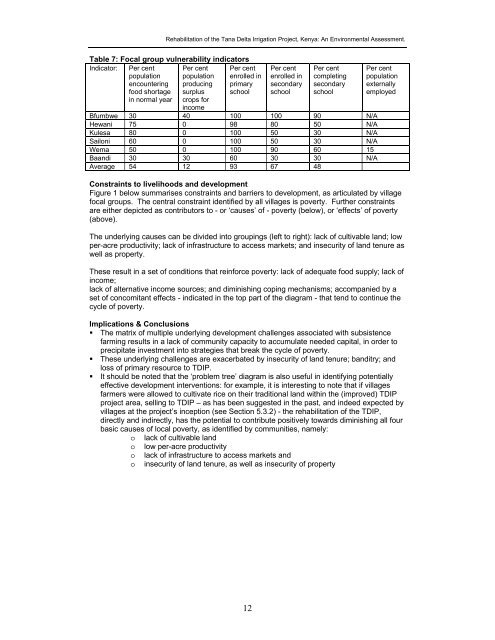Tana Delta Irrigation Project, Kenya: An Environmental Assessment
Tana Delta Irrigation Project, Kenya: An Environmental Assessment
Tana Delta Irrigation Project, Kenya: An Environmental Assessment
You also want an ePaper? Increase the reach of your titles
YUMPU automatically turns print PDFs into web optimized ePapers that Google loves.
Rehabilitation of the <strong>Tana</strong> <strong>Delta</strong> <strong>Irrigation</strong> <strong>Project</strong>, <strong>Kenya</strong>: <strong>An</strong> <strong>Environmental</strong> <strong>Assessment</strong>.<br />
Table 7: Focal group vulnerability indicators<br />
Indicator: Per cent<br />
population<br />
encountering<br />
food shortage<br />
in normal year<br />
Per cent<br />
population<br />
producing<br />
surplus<br />
crops for<br />
income<br />
Per cent<br />
enrolled in<br />
primary<br />
school<br />
Per cent<br />
enrolled in<br />
secondary<br />
school<br />
Per cent<br />
completing<br />
secondary<br />
school<br />
Bfumbwe 30 40 100 100 90 N/A<br />
Hewani 75 0 98 80 50 N/A<br />
Kulesa 80 0 100 50 30 N/A<br />
Sailoni 60 0 100 50 30 N/A<br />
Wema 50 0 100 90 60 15<br />
Baandi 30 30 60 30 30 N/A<br />
Average 54 12 93 67 48<br />
Per cent<br />
population<br />
externally<br />
employed<br />
Constraints to livelihoods and development<br />
Figure 1 below summarises constraints and barriers to development, as articulated by village<br />
focal groups. The central constraint identified by all villages is poverty. Further constraints<br />
are either depicted as contributors to - or ‘causes’ of - poverty (below), or ‘effects’ of poverty<br />
(above).<br />
The underlying causes can be divided into groupings (left to right): lack of cultivable land; low<br />
per-acre productivity; lack of infrastructure to access markets; and insecurity of land tenure as<br />
well as property.<br />
These result in a set of conditions that reinforce poverty: lack of adequate food supply; lack of<br />
income;<br />
lack of alternative income sources; and diminishing coping mechanisms; accompanied by a<br />
set of concomitant effects - indicated in the top part of the diagram - that tend to continue the<br />
cycle of poverty.<br />
Implications & Conclusions<br />
• The matrix of multiple underlying development challenges associated with subsistence<br />
farming results in a lack of community capacity to accumulate needed capital, in order to<br />
precipitate investment into strategies that break the cycle of poverty.<br />
• These underlying challenges are exacerbated by insecurity of land tenure; banditry; and<br />
loss of primary resource to TDIP.<br />
• It should be noted that the ‘problem tree’ diagram is also useful in identifying potentially<br />
effective development interventions: for example, it is interesting to note that if villages<br />
farmers were allowed to cultivate rice on their traditional land within the (improved) TDIP<br />
project area, selling to TDIP – as has been suggested in the past, and indeed expected by<br />
villages at the project’s inception (see Section 5.3.2) - the rehabilitation of the TDIP,<br />
directly and indirectly, has the potential to contribute positively towards diminishing all four<br />
basic causes of local poverty, as identified by communities, namely:<br />
o lack of cultivable land<br />
o low per-acre productivity<br />
o lack of infrastructure to access markets and<br />
o insecurity of land tenure, as well as insecurity of property<br />
12

















